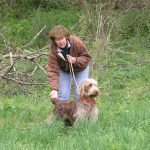Pointing Dog Pointers: Time for a Tune-Up?
Just as you take your auto to the shop each year to get it checked out, taking the time to do the same with your pointing dog will sharpen, or fine tune, his performance. We like to call this practice a “tune-up,” although that phrase may be going out of style!
Over the years we’ve trained a lot of dogs that have later come back to our kennel for tune-ups. It might be a mature, seasoned hunting dog whose owner is vacationing and wants his dog to have “summer camp” fun with us. Another client may have a pup between one and two years old that has developed some issues that need to be addressed. Still others don’t have the time, grounds, or birds to give their dogs a good tune up. Our tune-ups are generally for a month.
Whatever our returning student’s age, we always focus on three main things:
- Evaluation in the yard and field
- Plenty of bird work
- Issues or weakness that crop up
Evaluation in the Yard and Field
Our first order of business is to get our pup or older dog out in the yard on a six-foot lead. How well is he heeling? Almost all dogs can use a reminder on what it means to properly heel by our side, without lunging or pulling us.
Next, depending on the dog’s age and training, what kind of a whoa does he have? For first and second season young dogs, a basic whoa is sufficient. Pup should remain standing still on the whoa command while we walk in front of him and around him, giving the hand signal to “whoa” as we do so. If our dog is a seasoned, finished dog, his whoa should be staunch and impeccable. We can test this dog out by carrying a few birds in our vest, putting him on a whoa, and casually releasing a bird from a good distance away while he is on the whoa.
Finally, our dog should come on command, without fail, whatever his age. For this exercise, we use the checkcord on our student to test him out. We use the command “here” to call our dogs to us, but whatever command you use, use it only once. If pup doesn’t pay attention and come to us on the first command, the next time we call him, we will pop that checkcord on his neck at the exact same time. If our pup’s owner has kept him in practice with regular training, within a few sessions our student should be doing tip-top, polished yard work.
From there we head to the field – without birds for now – to see how our dog is handling in the field. We keep the checkcord on him and walk in a forward pattern, occasionally changing directions to the left or right. Pup should be used to the whistle that alerts him to these direction changes, and he should respond by looking to us and changing course with us. We want pup to always be working in a forward pattern, but in the real world of hunting, our dog may be changing directions on his own as he covers birdy objectives, and that’s what he’s supposed to do.
For our evaluation purposes, we want to see if our dog is paying attention to us and changing direction when we gesture and whistle. We also test him on coming directly to us when called, in the field. If the dog isn’t paying attention, we’ll spend as much time as necessary to remind him that we are hunting partners and need to work together. We use our checkcord to enforce our whistle and voice commands. Eventually, we should be able to drop the checkcord and have pup handling well for us.
Bird Work
After the yard work and field handling practice, it’s time to get our dog out on birds in the field, where we continue to use the checkcord. We use both quail and pigeons, planted in a variety of ways depending on the age and experience of the student. For pups hunted just a season or two, we may refrain from using metal bird traps until we see how staunch they are on point. Spinning or dizzying birds and dropping them lightly into cover usually works best. We use our checkcord to keep the younger dog from jumping in on the bird, as this may soften his point. Well-trained, seasoned dogs can work without the checkcord, although we may be using an e-collar if they have been trained to work with one.
Bird work needs to be fun, always ending on a positive note. We use a blank gun as the bird is flushed, and we shoot a few birds over our dog before the tune-up month is over. We give pup the opportunity to retrieve as well, but if he’s not a natural retriever, we don’t push this issue. With the dog that does retrieve, whether naturally or trained to do so, we make sure that our dog retrieves to hand.
Issues or Weaknesses
Depending on how long ago we trained a particular dog that has come back for a tune-up, we may find some issues that now need attention. Pup’s owner may be aware of some problems that have developed and discussed them with us. For example, the dog may show signs of being shy or fearful. On the flip side, he may be overly bold and is now self-hunting, getting way out of range and far from his owner. Maybe this self-assured fellow even bolts when he gets a chance. Or perhaps a younger dog may be showing some undue sensitivity to the gun. Maybe the dog that is retrieving has a hard mouth. Or it could be that our student is blinking birds or false pointing.
Simpler issues may be able to be resolved in a month, but with more serious problems like gun nervousness, blinking, and fearfulness we need to discover the reasons behind the behavior first and then work out a plan to address the problem – without a set timetable. We want positive results brought about by thoughtful solutions and gentle retraining.
Do you need a professional trainer to give your dog a tune-up? If you’ve access to some training grounds and birds that you can use for your pup, you can follow these guidelines for tuning up your pointing dog on your own. Polishing up on your dog’s yard work can be done at home. Whether you do your tune-up in the spring or fall, be aware of nesting restrictions, your time limitations, and the weather. Working in early spring or fall in the cooler times of day is best.
If you run into some serious problems or issues, it might be a good idea to get some professional advice. The ounce of prevention is always worth the pound of cure. Good training is really never over – the tune-up is just proper yearly maintenance to keep your pup in top shape.
Pointing Dog Pointers features monthly training tips by Bob and Jody Iler, who own Green Valley Kennels in Dubuque, Iowa. Bob and Jody have trained pointing dogs for over 35 years and have written many articles for The Pointing Dog Journal.








